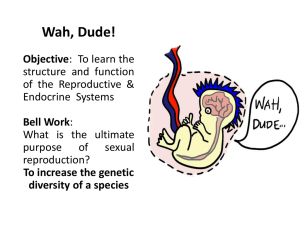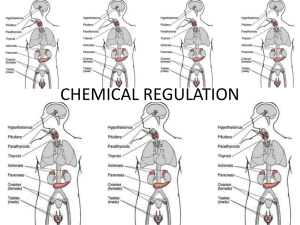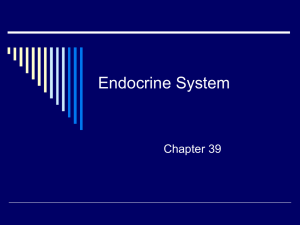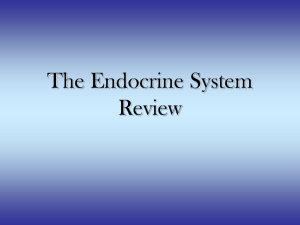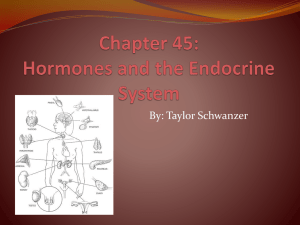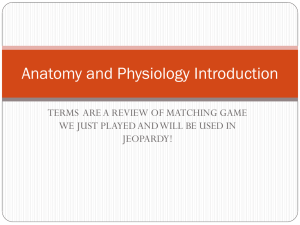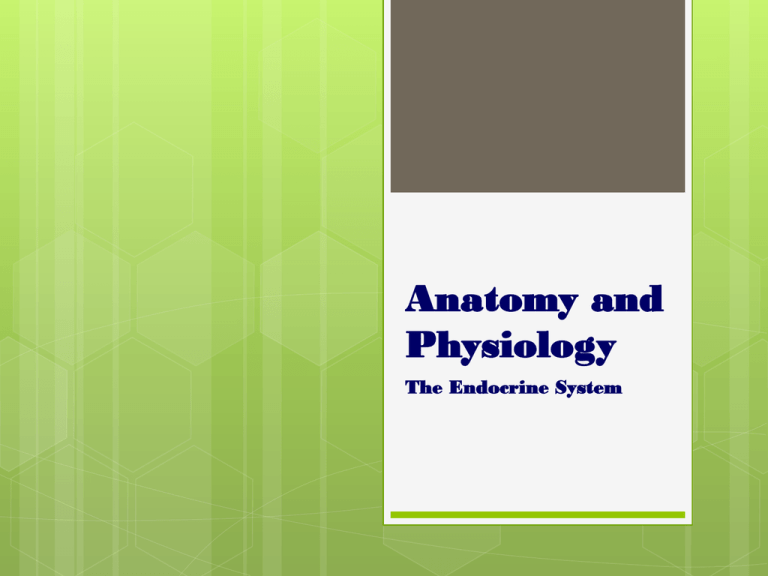
Anatomy and
Physiology
The Endocrine System
The
endocrine system includes anything that
secretes hormones directly into body fluids.
Endocrine
glands include: the thyroid, parathyroid,
adrenal, kidney, hypothalamus, pituitary, pineal,
pancreas, ovaries, testes, and thymus glands.
The
function of the endocrine systems is to regulate
metabolic pathways (chemical rxns, electrolyte
balance, membrane transport, reproduction, &
digestion) by secreting hormones.
http://www.worsleyschool.net/science/files/ho
rmones/mainpic.gif
Some terms:
Hormone:
a biochemical that affects a specific
metabolic pathway in another cell.
These
are secreted into body fluids & blood.
These
are mostly steroids and made from
cholesterol but some are amines, peptides,
proteins, and glycoproteins.
Target
cells (or organs): cells or organs that receive
the hormone (cell that is affected). These cells have
binding sites (a.k.a. receptors) for specific
hormones.
Hormones
are placed in 2 groups: Steroid hormones
and Nonsteroid hormones.
Steroid
Hormones: lipid soluble, meaning they easily
pass (diffuse) thru membranes. These are formed
from cholesterol usually.
Nonsteroid
hormones must bind to receptors of
target cells (do not diffuse thru membranes). These
are amines, peptides, proteins, and glycoproteins.
Hormonal Secretion Control:
This
is done by negative feedback control.
Mechanism
that regulates the production of
hormones based on the accumulation of
another substance along a metabolic
pathway.
For example:
The adrenal gland produces chemical A
which continues a pathway:
A BC D E
When
E is accumulated, it prevents (or
inhibits) the adrenal gland from producing A.
This is a negative feedback mechanism.
http://faculty.clintoncc.suny.edu/faculty/Michael.G
regory/files/Bio%20102/Bio%20102%20lectures/e
ndocrine%20system/cortisol.gif
http://www.google.com/imgres
The Endocrine
Glands and
Their Hormones
The Pituitary Gland:
found in the base of the brain
has 2 parts: anterior and posterior (based on the lobe of the
brain in which it is found).
controlled by the hypothalamus (by releasing hormones)
http://images.encarta.msn.com/xrefmedia/aencmed/targets/illus
/ilt/T012393A.gif
The Pituitary Hormones:
Anterior Pituitary Hormones:
Growth Hormone (GH): stimulates growth of
cells (increase in size & cell division).
Prolactin
(PRL): stimulates and sustains the
milk production in new mothers.
Thyroid-Stimulating
Hormone (TSH): controls
thyroid gland secretions and is partially
regulated by the hypothalamus.
Anterior Pituitary Hormones (cont’d):
Adrenocorticotropic hormone (ACTH):
controls the hormone production of the
adrenal cortex. Stress may increase ACTH.
Follicle-stimulating hormone (FSH) and
luteinizing hormone (LH): are released in
the gonads (testes and ovaries). These are
called gonadotropins.
The Posterior Hormones:
Antidiuretic hormone (ADH): decreases urine
production by regulating the amount of
water the kidneys excrete; therefore,
regulating [water] in body fluids.
Oxytocin
(OT): considered an antidiuretic; it
stimulates the uterine muscles to contract
(causing contractions & birth), lactation b/c
it stimulates milk-producing glands, and milk
ejection.
The Thyroid Gland and its hormones:
This
is located on both sides of the larynx and in front
of the trachea.
Thyroxine
(a.k.a. T4 or tetraiodothyronine) has 4
atoms of iodine and Triiodothyronine (a.k.a. T3) has
3 atoms of iodine (is 5 times stronger). Both regulate
the metabolism of carbs (stimulate their use),
proteins (stimulate their production), & lipids
(stimulate their breakdown).
Calcitonin:
not technically a thyroid hormone (b/c
of the location of production). This regulates the
[Ca] and [phosphate ions] in the blood.
Thyroid
http://stb.msn.com/i/D8/DF6013611CDFDC22A8FB8E28C1DFF.jpg
The Parathyroid Glands and their hormones:
These
4 are found on the thyroid gland.
These
secrete parathyroid hormone (PTH): increases
blood [Ca++] and decreases blood [phosphate ion],
affecting the kidneys, bones & intestines. This works
with calcitonin and is regulated by the [ ] of these
ions in the blood.
http://stb.msn.com/i/BD/F8BC26E3251ABD2F3FEA4
607A1D47.jpg
The Adrenal Glands and their hormones:
This
is located on top
of the kidneys and
contains 2 portions:
adrenal
medulla
(central portion)
adrenal
portion).
cortex (outer
http://www.massgeneral.org/cancer/crr/types/endocrine/images/
adrenal_gland.jpg
The Adrenal Cortical Hormones:
Aldosterone: regulates the [mineral] in the
blood, stimulating water retention and
sustaining b.p. and volume.
Cortisol: a.ka. hydrocortisone, affects
glucose, protein & fat metabolism.
Adrenal Sex Hormones: in males, a.k.a.
adrenal androgens; in females, a.k.a.
estrogens. These supplement sex
hormones & stimulate gonad
development.
The Adrenal Medulla Hormones:
Epinephrine
(a.k.a. adrenaline) and
norepinephrine (a.k.a. noradrenaline) are
released simultaneously. These increase the
heart rate, increase heart contractions,
increase breathing rate, increase b.p.,
increase blood glucose levels, & decrease
digestion causing the typical “fight or flight
reaction”
The Pancreas and its Hormones:
This is found by the
stomach and has 2
functions: exocrine
gland (secretes
digestive juices) and
endocrine (releasing
hormones).
The endocrine
section contains
groups of cells known
as the Islets of
Langerhans which
contain alpha cells
(secrete glucagon)
and beta cells
(secrete insulin).
http://www.pancreatic.org/atf/cf/%7BA69EE36
7-5C5C-4B26-A09464E9EA47D990%7D/image001.jpg
The Pancreatic Hormones:
Glucagon: produced by alpha cells;
stimulates the breakdown of glycogen and
amino acids. It raises [blood sugar] and is
regulated by a low blood sugar
(hypoglycemia).
Insulin:
produced by beta cells; stimulates the
liver to make glycogen, promotes the
transport of glucose into cells, stimulates
protein synthesis and stimulates fat storage;
thus, it decreases [blood sugar] and is
regulated by a high blood sugar
(hyperglycemia).
Blood
Sugar
Regulation:
http://www.endocrineweb.com/images/su
gar.gif
Other
Endocrine
Glands
Pineal Glands:
This is found in the
brain on the upper
portion of the
thalamus.
This
secretes
melatonin which
regulates circadian
rhythms (response to
light and dark
conditions of the
environment. These
rhythms dictate sleep
patterns & seasonal
cycles of fertility in
some mammals.
http://training.seer.cancer.gov/module_anatomy/images/illu_pituitary_
pineal_glands.jpg
Thymus Gland:
This is found between the
lungs (shrinks with age).
This
secretes thymosins
which regulate the
production &
differentiation of white
blood cells, specifically
T cells (T lymphocytes)
http://www.besthealth.com/besthealth/bodyguide/reftex
t/images/Thymus_spleen.jpg
Reproductive Glands:
Ovaries: produce estrogens & progesterone
Testes: produce testosterone
Placenta: produces estrogens, progesterone
& gonadotropin
http://www.nlm.nih.gov/medlineplus/enc
y/images/ency/fullsize/17122.jpg
http://www.actionhealthinc.org/teenzone/ima
ges/female.jpg
http://www.malecontraceptives.org/methods/im
ages/heat.jpg
Heart:
produces atrial natriuretic peptide
(stimulates urinary Na secretion).
Kidneys:
produce erythropoietin (stimulates
the production of rbc’s).
http://www.nhlbi.nih.gov/health/dci/images/heart_interior.gif
http://www.healthline.com/blogs/health_observances/upl
oaded_images/kidney-713543.jpg
Stress and Health:
Stress
is defined as a
condition that causes
change in the internal
environment (a
physiological response
that alters homeostasis).
A
stressor is a factor that
causes stress.
http://www.google.com/imgres
Stress and Health:
There are types of
stressors:
physical which can be
temperature changes
internally or externally,
[O2] changes, injury,
illness (infections),
exercise, noise, etc.
psychological factors
which include emotions,
feelings (anger, joy, fear,
grief, anxiety, depression,
etc.), thoughts, losses,
unpleasant and pleasant
encounters, and sexual
arousals/encounters.
http://www.google.com/imgres
Response to stress: These are physiological
responses, called general stress syndrome,
which is an adaptation to general stress.
This
is controlled by the hypothalamus which
activates fight or flight rxns (increases
epinephrine output).
The physical responses include:
Increased
[blood glucose] levels
increased
heart rate
increased
rate of breathing
increased
b.p.
air
passage dilation
http://www.google.com/imgres
Other
hormones are increased in output as
well: glucagons, GH (both increase use of
energy sources) and ADH (decrease urine
output, conserving water, & maintaining
blood volume).
In
addition, cortisol is increased which
decreases the # of lymphocytes (increasing
risk of infection/illness by lowering
resistance and increasing the risk of high
b.p., GI ulcers and atherosclerosis).
Look
up online or in text!
Know the following:
dwarfism, gigantism, acromegaly, diabetes
insipidus, goiters, Grave’s disease, cretinism,
exophthalmos, tetany, Addison’s disease,
Cushing’s syndrome, diabetes mellitus, ketosis,
polyuria, polydipsia, polyphagia, insulin
resistance, and menopause.




